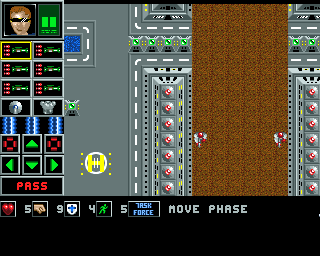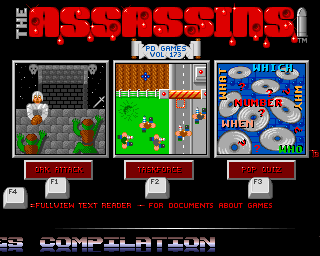
Task Force is a tactical squad based strategy game released around 1994 for the Commodore Amiga. Like many Amiga games of that era, it was created by a single author and freely distributed on floppy disk via public domain distribution companies.
Development
Task Force was written entirely in 68k assembly language by Mark Sheeky. This interview suggests it was some version of the HiSoft Devpac assembler in particular, originally known as GenAm.
Aside from the Protracker play routine, which I assume is an external library, the game uses 4,549 lines of code, or 3,652 if we want to ignore blank lines and comments. For comparison, K240 is about 40,000 lines, around ten times as many. Task Force included about 160KB of graphics, 100KB of sound, and two pieces of music, all produced by Sheeky himself.
Several parts of the game code mentioned that they are adapted from an existing set of routines used for the author’s previous games. This would help to explain how he was able to produce multiple games every year.
From the order of the map tiles, we might speculate that mines were in the game from early on, then doors may have been added later, then field obstacles like fences and trees, and rescuable prisoners last of all. However, the tile order may be entirely arbitrary, being arranged into sets of ground, walls, and soldiers.
We might also infer that colors were added to the game’s single palette in order of necessity. After black and grey are six pairs of light and dark colors of the rainbow, a base palette. Next are darker green, browns and greys used by the military setting. After this are salmon pink and powder blue, another green-grey, a beige skin tone, darker variants of three rainbow colors, two shades of beige for more skin tones, and three shades of bluish-greys. Finally, two colors push the game into needing a 32-color palette: a bright blue (perhaps needed for the title image) and another black (color 0 probably generally used for background). A more careful use of palette could reduce that to 16 colors, although this would only be necessary for games with more moving graphics.
This was the author’s tenth Amiga game or so since 1991.
Release
Task Force is variously stated online to have been released in 1993 or 1994, and to be either freeware or shareware. I’ll try to narrow down the date here.
It was distributed both on a CU Amiga coverdisk, and on various Public Domain disk releases. While the author remembers on the Itch.io page that it was a shareware game which received no purchases, in fact the game never mentioned shareware or a registration fee. It had no external readme file, and while the in-game documentation invited players to write to express their interested in a “full” version of the game, no price was listed and no such version was ever made.
Like many Amiga games, the file dates in Task Force are unreliable for dating the game’s production. The lack of a real-time clock in the most popular Amiga models often resulted in inaccurate dates, such as 1 Jan 1978. Task Force is different in that, bizarrely, its files are set the future date of 17 Oct 2020.
As we will see from the known releases, the game must have been released between late 1993 and early 1994, probably within the range Sept 1993 and Apr 1994.
Known releases

Assassins Games #173
Task Force appeared on Assassins Games #173, a compilation of three games with Ork Attack and Pop-Quiz. Screenshots were not as easy back then, so the menu screen actually redraws a scene from the game from scratch. To fit on the disk, it is compressed with CrunchMania Normal, to 136,564 bytes. The game has credits for the intro, but the intro do not appear on this disk due to space constraints.
Assassins Games #173 gives a clue that the game may have been first released in 1993. The compressed version of the main game executable is dated 29 Sept 1993. This date is not guaranteed correct, since some Amigas would take their date from the OS install date of a hard disk, but it is plausible.
CU Amiga Magazine (Apr 1994) includes the game on Coverdisk 78.
It provides the game as a DMS file on disk, dated 15 Feb 1994, which is correct
for when the issue would have been compiled. The disk itself has the volume name
Copy_of_Taskforce. It omits the intro to save space, which necessitated an
edit of the startup-sequence, that file dated 20 Oct 1993. This gives the
clearest indication that CU Amiga received the finished game around that date.
Page 23 of that issue also
devotes itself to describing the gameplay.
A review in The One Amiga (May 1994) asserts that it was released by 17 Bit Software as Disk 299. In fact this is a typo; 17 Bit’s Phase Four CD-ROM numbers it Disk 2996.
It was released via PD Soft on their Disk 3897. It was later included in their compilation CD-ROM Hottest 4, although the clearly false file date of 25 Apr 1980 is unhelpful. However, the chronologically earlier disks 3603 to 3760 are all dated 15 or 16 February 1994, so we might infer that PD Soft added the game to their collection after that date. This is very close to the date of 14 February 1994 for the DMS on the CU Amiga coverdisk.
Berliner Spielekiste #472, a compilation disk from Berlin PD, features various file dates from 8 May 1994 to 8 July 1994. The disk’s title image is dated June 1994.
Amigasoft’s May 1995 catalogue disk lists a 1-disk action game named Taskforce as disk GA1261, but most of the other games in that list are proper retail commercial releases, and I suspect this is a pirate list and not public domain.
The Sep/Oct 1995 Sadeness PD catalog disk lists Task Force as disk SG361.
Version differences
Some Amiga freeware games had numerous different versions with different releases. Unlike commercial games, the developer was free to continue improving their game after the initial release. Task Force appears to have only been produced in one release build, after which the author moved on to another project.
The game files are dated 17 October 2020 around 6:35am (a false date, but
consistently replicated across versions). This is consistent with the original
source release, where the files are also dated 17 October 2020. The times are
off by a number of hours, but the minutes matches, suggesting some timezone
shenanigans. The only non-matching file in the source is mod.TaskforceTitle,
dated 18 October 1999, evidently originally stored separately and copied into
the source folder on a later date; and the Amiga icon file for the source
directory, which matches this date, meaning it was copied into that folder using
an Amiga.
It is therefore most likely that the source code reflects the same final build, which according to comments in the source is is “TASK FORCE v2.0” and bears a copyright notice of “* All code ©1993 by Scorpius Software all rights reserved.”
There are only a few differences between various distributions:
- Some compilation disks removed the intro. The intro already existed, since even these versions include credits for the intro creator. This suggests that those distributions simply stripped the intro to fit multiple games on the disk.
- Some disks, mainly non-compilation versions, include recoverable deleted data on disk. DiskSalv recovers source files representing a slightly earlier version of the game source code with small differences. See deleted files.
- The Assassins Games #173 release packs the main game executable with CrunchMania to fit on the disk. Unpacking it reveals a different executable which is 269,240 bytes instead of 277,220 bytes in size. The original version has the symbol table intact, which identifies variables and functions when the game is disassembled; the unpacked version is missing this, which probably accounts for the missing 7,980 bytes. I’m guessing that symbol table stripping is a feature of CrunchMania to reduce executable size.
Reception
Task Force was reviewed by a few magazines.
The One Amiga issue 68 (May 1994) reviewed the game at 69%. He thinks there are four missions, but every version of the game I’ve seen has eight mission files, so this is probably an error. The main advantage he gives is the price, being a freely distributable game.
Amiga Power issue 41 (Sep 1994) reviewed it with a more generous four stars out of five, calling it “a decent enough strategy RPG”. Pete Tenshus reviews the game via PD Soft’s release. He enjoys the overall concept of the game, but finds it too difficult and mission goals are unclear.
German magazine Amiga Joker featured it in their March 1995 issue, but didn’t give a score.
Legacy
While Task Force did not make any money, its inclusion on a CU Amiga led several interested folk to write in at the address he provided. One such individual was Andrew Cashmore, who provided the art for the Task Force inspired Hilt: Against the Hoardes (Aug 1994, according to the author’s old site), and Hilt 2 (Jan 1996), which received a 91% review in CU Amiga after a budget release from 5th Dimension Licenseware, but sold only around 10 copies. His most profitable Amiga game was Burnout, published by Vulcan, for which he earned £280 in royalties, although it was not reviewed well; CU Amiga rated it only 43%. Sheeky’s last Amiga game, Blade, (Aug 1997) was published by Alive Mediasoft, who reportedly never paid him. This was all too common in the late Amiga era; Team Hoi similarly reported being unpaid by Hollyware Entertainment for their game Hoi (1992), and again by Rasputin Software for their excellent puzzle game Clockwiser (1994).
In 1998 he switched to PC games with his new PC game company, Cornutopia, initially producing PC remakes of his Amiga games. In October 2004, they released a sequel or remake of Task Force, titled Taskforce: The Mutants of October Morgane. He wrote PC games until 2008, and after 2017 or so began releasing re-mastered versions of his PC games on Steam.
On July 24, 2020, a remastered version of PC Taskforce was re-released on Steam for $15.99. At time of writing it has no reviews on the site.
There’s a wonderful dichotomy in the history of Sheeky’s games. On one hand, the company was never financially successful: no game ever made more than £280 (less than a month at minimum wage today, adjusting for inflation) and none of their shareware games received a registration. Their most successful game on Steam is Flatspace (2020), a free game with 18 reviews; followed by Flatspace IIk (2017), a $15.99 game with 12 reviews but Mixed rating.
Yet over the span of about 15 years he released about 22 games for Amiga and 24 for PC, a prodigous number. I would estimate that most independent developers nowadays never even finish their first game, and most who manage it are disheartened by their lack of success and give up before publishing a second game. Yet here is a company that showed it is possible for one dedicated, self-taught coder to make a video game in under a year, if you set a realistic scope; and even if it is poorly reviewed or does not make money, you can try again and again.
« Back to index page